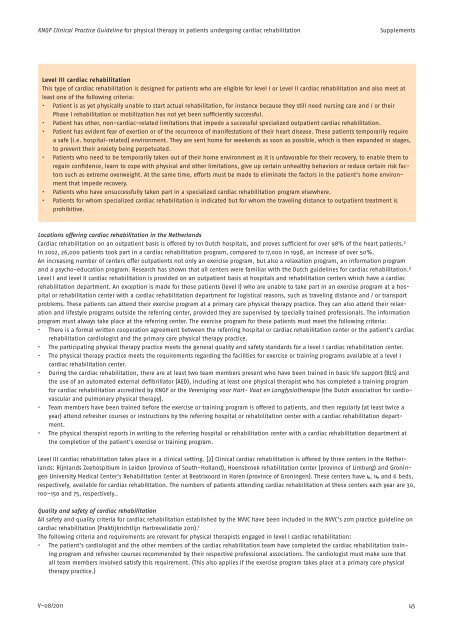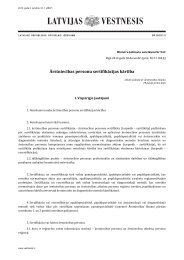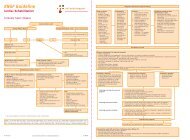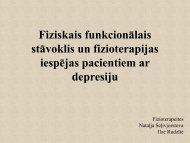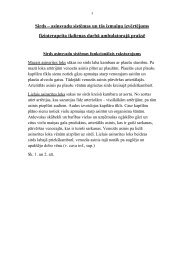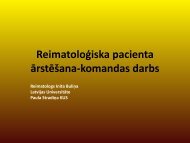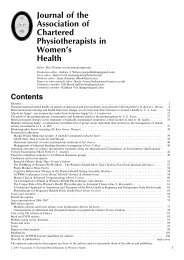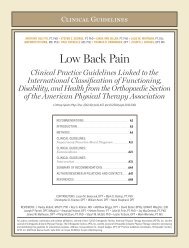KNGF Guideline Cardiac rehabilitation
KNGF Guideline Cardiac rehabilitation
KNGF Guideline Cardiac rehabilitation
You also want an ePaper? Increase the reach of your titles
YUMPU automatically turns print PDFs into web optimized ePapers that Google loves.
<strong>KNGF</strong> Clinical Practice <strong>Guideline</strong> for physical therapy in patients undergoing cardiac <strong>rehabilitation</strong><br />
Supplements<br />
Level III cardiac <strong>rehabilitation</strong><br />
This type of cardiac <strong>rehabilitation</strong> is designed for patients who are eligible for level I or Level II cardiac <strong>rehabilitation</strong> and also meet at<br />
least one of the following criteria:<br />
• Patient is as yet physically unable to start actual <strong>rehabilitation</strong>, for instance because they still need nursing care and / or their<br />
Phase I <strong>rehabilitation</strong> or mobilization has not yet been sufficiently successful.<br />
• Patient has other, non-cardiac-related limitations that impede a successful specialized outpatient cardiac <strong>rehabilitation</strong>.<br />
• Patient has evident fear of exertion or of the recurrence of manifestations of their heart disease. These patients temporarily require<br />
a safe (i.e. hospital-related) environment. They are sent home for weekends as soon as possible, which is then expanded in stages,<br />
to prevent their anxiety being perpetuated.<br />
• Patients who need to be temporarily taken out of their home environment as it is unfavorable for their recovery, to enable them to<br />
regain confidence, learn to cope with physical and other limitations, give up certain unhealthy behaviors or reduce certain risk factors<br />
such as extreme overweight. At the same time, efforts must be made to eliminate the factors in the patient’s home environment<br />
that impede recovery.<br />
• Patients who have unsuccessfully taken part in a specialized cardiac <strong>rehabilitation</strong> program elsewhere.<br />
• Patients for whom specialized cardiac <strong>rehabilitation</strong> is indicated but for whom the traveling distance to outpatient treatment is<br />
prohibitive.<br />
Locations offering cardiac <strong>rehabilitation</strong> in the Netherlands<br />
<strong>Cardiac</strong> <strong>rehabilitation</strong> on an outpatient basis is offered by 101 Dutch hospitals, and proves sufficient for over 98% of the heart patients. 2<br />
In 2002, 26,000 patients took part in a cardiac <strong>rehabilitation</strong> program, compared to 17,000 in 1998, an increase of over 50%.<br />
An increasing number of centers offer outpatients not only an exercise program, but also a relaxation program, an information program<br />
and a psycho-education program. Research has shown that all centers were familiar with the Dutch guidelines for cardiac <strong>rehabilitation</strong>. 3<br />
Level I and level II cardiac <strong>rehabilitation</strong> is provided on an outpatient basis at hospitals and <strong>rehabilitation</strong> centers which have a cardiac<br />
<strong>rehabilitation</strong> department. An exception is made for those patients (level I) who are unable to take part in an exercise program at a hospital<br />
or <strong>rehabilitation</strong> center with a cardiac <strong>rehabilitation</strong> department for logistical reasons, such as traveling distance and / or transport<br />
problems. These patients can attend their exercise program at a primary care physical therapy practice. They can also attend their relaxation<br />
and lifestyle programs outside the referring center, provided they are supervised by specially trained professionals. The information<br />
program must always take place at the referring center. The exercise program for these patients must meet the following criteria:<br />
• There is a formal written cooperation agreement between the referring hospital or cardiac <strong>rehabilitation</strong> center or the patient’s cardiac<br />
<strong>rehabilitation</strong> cardiologist and the primary care physical therapy practice.<br />
• The participating physical therapy practice meets the general quality and safety standards for a level I cardiac <strong>rehabilitation</strong> center.<br />
• The physical therapy practice meets the requirements regarding the facilities for exercise or training programs available at a level I<br />
cardiac <strong>rehabilitation</strong> center.<br />
• During the cardiac <strong>rehabilitation</strong>, there are at least two team members present who have been trained in basic life support (BLS) and<br />
the use of an automated external defibrillator (AED), including at least one physical therapist who has completed a training program<br />
for cardiac <strong>rehabilitation</strong> accredited by <strong>KNGF</strong> or the Vereniging voor Hart- Vaat en Longfysiotherapie (the Dutch association for cardiovascular<br />
and pulmonary physical therapy).<br />
• Team members have been trained before the exercise or training program is offered to patients, and then regularly (at least twice a<br />
year) attend refresher courses or instructions by the referring hospital or <strong>rehabilitation</strong> center with a cardiac <strong>rehabilitation</strong> department.<br />
• The physical therapist reports in writing to the referring hospital or <strong>rehabilitation</strong> center with a cardiac <strong>rehabilitation</strong> department at<br />
the completion of the patient’s exercise or training program.<br />
Level III cardiac <strong>rehabilitation</strong> takes place in a clinical setting. [2] Clinical cardiac <strong>rehabilitation</strong> is offered by three centers in the Netherlands:<br />
Rijnlands Zeehospitium in Leiden (province of South-Holland), Hoensbroek <strong>rehabilitation</strong> center (province of Limburg) and Groningen<br />
University Medical Center’s Rehabilitation Center at Beatrixoord in Haren (province of Groningen). These centers have 4, 14 and 6 beds,<br />
respectively, available for cardiac <strong>rehabilitation</strong>. The numbers of patients attending cardiac <strong>rehabilitation</strong> at these centers each year are 30,<br />
100–150 and 75, respectively..<br />
Quality and safety of cardiac <strong>rehabilitation</strong><br />
All safety and quality criteria for cardiac <strong>rehabilitation</strong> established by the NVVC have been included in the NVVC’s 2011 practice guideline on<br />
cardiac <strong>rehabilitation</strong> (Praktijkrichtlijn Hartrevalidatie 2011). 1<br />
The following criteria and requirements are relevant for physical therapists engaged in level I cardiac <strong>rehabilitation</strong>:<br />
• The patient’s cardiologist and the other members of the cardiac <strong>rehabilitation</strong> team have completed the cardiac <strong>rehabilitation</strong> training<br />
program and refresher courses recommended by their respective professional associations. The cardiologist must make sure that<br />
all team members involved satisfy this requirement. (This also applies if the exercise program takes place at a primary care physical<br />
therapy practice.)<br />
V-08/2011<br />
45


